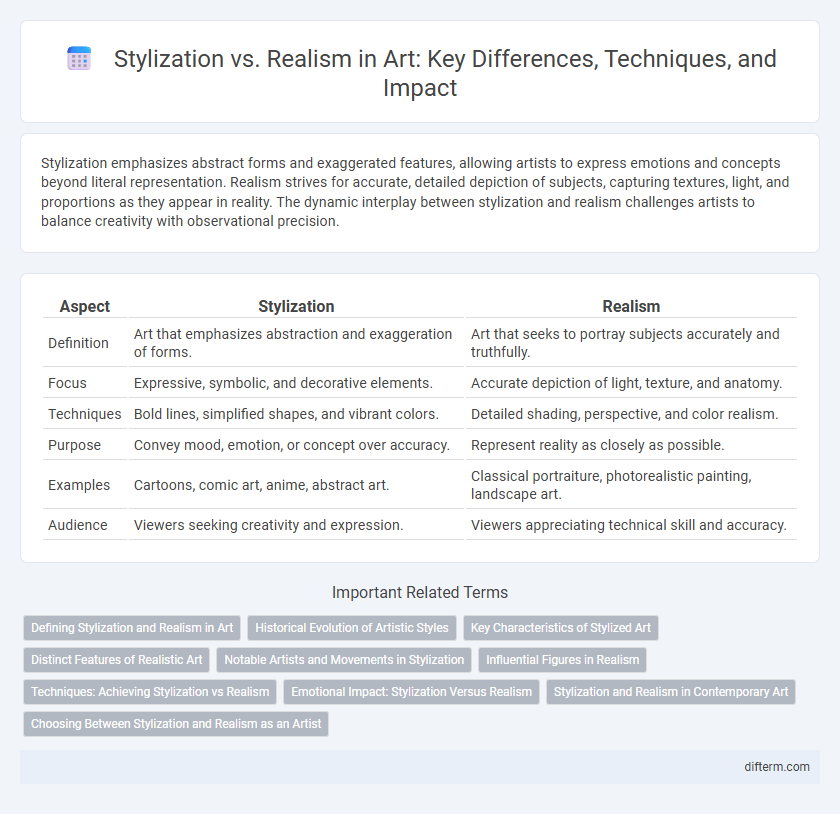Stylization emphasizes abstract forms and exaggerated features, allowing artists to express emotions and concepts beyond literal representation. Realism strives for accurate, detailed depiction of subjects, capturing textures, light, and proportions as they appear in reality. The dynamic interplay between stylization and realism challenges artists to balance creativity with observational precision.
Table of Comparison
| Aspect | Stylization | Realism |
|---|---|---|
| Definition | Art that emphasizes abstraction and exaggeration of forms. | Art that seeks to portray subjects accurately and truthfully. |
| Focus | Expressive, symbolic, and decorative elements. | Accurate depiction of light, texture, and anatomy. |
| Techniques | Bold lines, simplified shapes, and vibrant colors. | Detailed shading, perspective, and color realism. |
| Purpose | Convey mood, emotion, or concept over accuracy. | Represent reality as closely as possible. |
| Examples | Cartoons, comic art, anime, abstract art. | Classical portraiture, photorealistic painting, landscape art. |
| Audience | Viewers seeking creativity and expression. | Viewers appreciating technical skill and accuracy. |
Defining Stylization and Realism in Art
Stylization in art emphasizes the deliberate alteration of natural forms to express emotions, ideas, or aesthetics through exaggerated shapes, colors, and lines. Realism aims to depict subjects with precise accuracy, reflecting true-to-life appearances and detailed textures to create a lifelike representation. Both approaches offer distinct artistic perspectives, influencing how viewers interpret visual narratives and emotional depth.
Historical Evolution of Artistic Styles
The historical evolution of artistic styles reveals a dynamic interplay between stylization and realism, tracing back to ancient civilizations such as Egypt and Greece where symbolic abstraction coexisted with anatomical study. During the Renaissance, mastery of realistic representation reached new heights through techniques like linear perspective and chiaroscuro, emphasizing lifelike detail and spatial accuracy. The 20th century witnessed a resurgence of stylization through movements like Cubism and Expressionism, challenging traditional realism by prioritizing emotional expression and abstract forms.
Key Characteristics of Stylized Art
Stylized art emphasizes exaggerated features, simplified forms, and vibrant colors to convey emotion and character rather than precise realism. This art style often abstracts reality by focusing on bold outlines, flat shapes, and symbolic elements that enhance visual storytelling. Key characteristics include intentional distortion, aesthetic uniformity, and a playful approach to detail, creating a unique visual language distinct from photorealistic representation.
Distinct Features of Realistic Art
Realistic art is characterized by meticulous attention to detail, accurate depiction of light and shadow, and lifelike textures that create a convincing illusion of three-dimensionality. It emphasizes precise proportions, natural color palettes, and faithful representation of subjects to capture true-to-life appearances. The goal of realism is to portray the ordinary world with clarity and authenticity, distinguishing it from stylized forms that prioritize abstract or exaggerated elements.
Notable Artists and Movements in Stylization
Notable artists in stylization include Henri Matisse, whose use of bold colors and simplified forms defined Fauvism, and Pablo Picasso, a pioneer of Cubism emphasizing abstract representation over realism. The Art Nouveau movement is characterized by its ornamental, flowing lines and symbolic shapes, while Expressionism, led by artists like Edvard Munch, focused on evoking emotional experience through stylized distortion. These movements prioritize subjective interpretation and imaginative aesthetics, contrasting with the detailed accuracy of Realism.
Influential Figures in Realism
Gustave Courbet pioneered the Realism movement in the mid-19th century by challenging Romantic idealism and portraying everyday scenes with striking authenticity. Jean-Francois Millet followed suit, emphasizing rural laborers and the dignity of peasant life through detailed, unembellished depictions. Edouard Manet bridged Realism and Impressionism, using bold brushwork to capture modern life with a candid, unvarnished perspective.
Techniques: Achieving Stylization vs Realism
Stylization in art employs techniques such as exaggeration of forms, simplified shapes, and deliberate distortion to convey emotion or symbolism, often utilizing bold lines, flat colors, and abstracted patterns. Realism requires meticulous observation and rendering of light, texture, and anatomy, with techniques like chiaroscuro, detailed brushwork, and accurate perspective to create lifelike representation. Mastery of these distinct approaches involves understanding of anatomy and color theory for realism, while stylization depends on creative abstraction and intentional departure from natural proportions.
Emotional Impact: Stylization Versus Realism
Stylization in art amplifies emotional impact by emphasizing expressive forms, colors, and exaggerated features that evoke strong, subjective responses from viewers. Realism captures intricate details and lifelike representations, fostering a deep connection through recognizable, authentic human experiences and natural environments. Both approaches manipulate visual elements to convey emotional narratives, with stylization prioritizing symbolic meaning and realism anchoring feelings in tangible reality.
Stylization and Realism in Contemporary Art
Stylization in contemporary art emphasizes abstract, exaggerated, or simplified forms that convey emotional expression or symbolic meaning, often challenging traditional perceptions of reality. Realism prioritizes accurate, detailed depictions of subjects, capturing the nuances of light, texture, and anatomy to represent the world faithfully. Contemporary art frequently blends stylization and realism, creating dynamic works that explore the tension between objective representation and subjective interpretation.
Choosing Between Stylization and Realism as an Artist
Choosing between stylization and realism depends largely on the artist's intent and the message they want to convey. Stylization offers creative freedom to exaggerate, simplify, or abstract elements, enhancing emotional impact and visual storytelling. Realism demands technical skill to accurately depict subjects, aiming to capture lifelike details and evoke authenticity.
Stylization vs Realism Infographic

 difterm.com
difterm.com